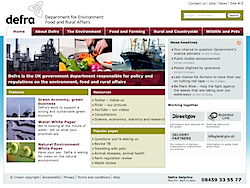
Sometimes I jokingly describe BIS as the ‘middle east of central government’: renamed/merged/split/reformed more than its fair share of the time. To be fair, Defra might have a claim to the same title, having been, within recent memory, bits of MAFF, DTLR, DETR, and DECC, plus more than its fair share of quangos.
In that turbulent terrain, Simon Everest, Head of Digital Engagement at Defra, and his colleague David Pearson are camped out defiantly on land they know is theirs, with a bazooka pointed at the hills of overgrown content and bloated IT.
Until last month, this major department of state with its ten-year, £400m IT contract with IBM had a website powered by Dreamweaver, struggling to keep a soup of tens of thousands of static pages organised, alongside the pressures to converge superfluous microsites and be innovative in its use of digital channels.
Simon, David and their team are waving, not drowning in this soup. A while back, they hived off consultations onto a WordPress-based platform to enable online discussion – and more importantly, they kept the pressure up internally on policy teams to join in with that discussion and leave their own comments. There’s an uncharacteristically (for government) striking-looking blog for Defra’s Third Sector work. And more recently, they went the whole hog and moved their entire corporate site to WordPress, using the change of government as a useful opportunity to rethink the purpose and architecture of the site.
Simon and David clearly aren’t afraid of some technical heavy lifting, but they’re also not afraid to challenge content owners. Government sites are huge not simply because government is big, but because web teams often don’t have the clout to push back against colleagues who want to build vast libraries of unmanaged content. Not so in Defra, where the new site has a slim 130-odd pages of content, re-written with the audience in mind.
Using WordPress has given the team a platform that can do a lot more, not least providing a very low cost offer to partner organisations needing their own compliant website. At the recent WordUp Whitehall event, Simon talked about how they were considering using WordPress’ built-in comments system as a private feedback mechanism, using a regular comment form to provide ‘Send us feedback on this page’ functionality, and using that feedback internally rather than publishing comments the traditional way. It’s a brilliant piece of lateral thinking which had a few jaws dropping around the room.
Perhaps the most impressive thing about this team, and why they really qualify as digital heroes, is that they haven’t taken the barriers of outsourced IT lying down. They’ve used talented small suppliers like Puffbox and Sweet Interaction, boxed clever for hosting, finding an entirely new enterprise-strength hosting option for less than the price of a Land Rover each year, all the while negotiating the intricacies of their IT contract. It’s hard to say quite how much money they’ve saved taxpayers, as Defra web costs are combined with other things. But I’m going to guess it’s either six figures or seven, and what’s more, Defra has a hugely more capable, well-organised, and well thought-through site as a consequence.
Three cheers Simon and David (and their colleagues).


Comments
Simon is one of my digital heroes too, he engages on twitter and farming forums and helps ordinary people too. Not just Defra. I think that is so important these days. To mix in a big society. Digitally.
chris
[…] the clout to be firm with Departments about the value and purpose of their content, much like the heroes at Defra have been. It would offer a lot of scope to develop common infrastructure for common requirements […]